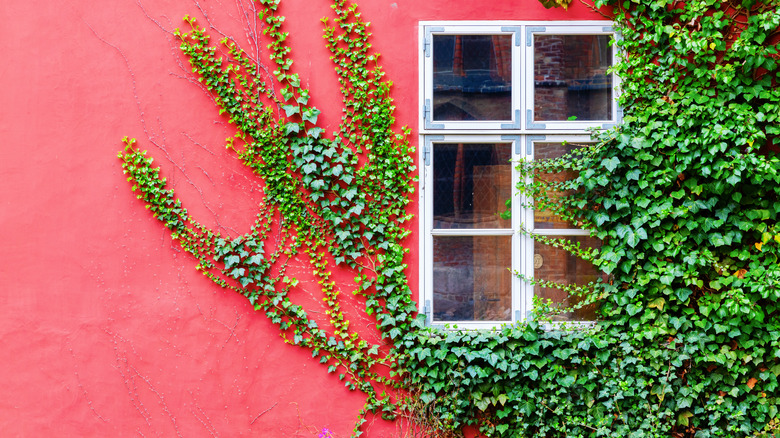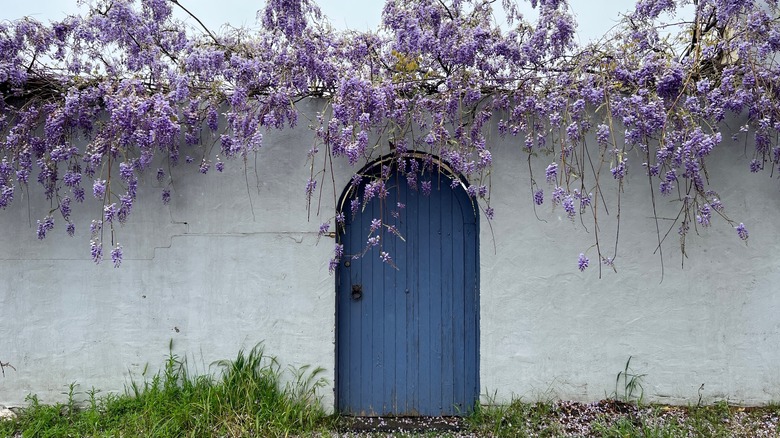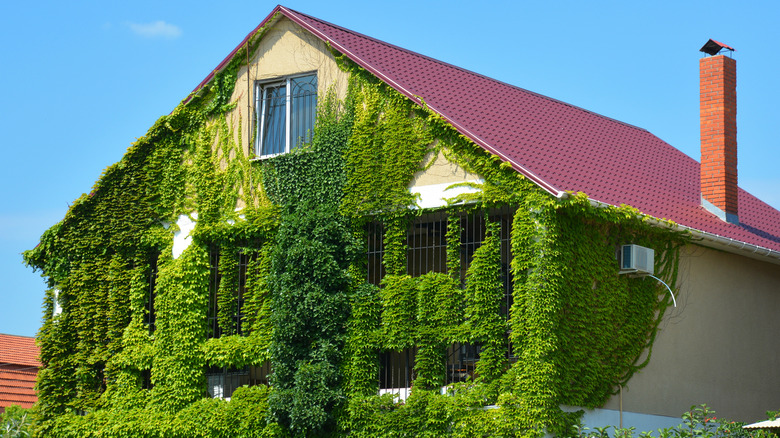Are Climbing Vines Damaging Your Home? Well, It Depends
Have you ever seen images of old cottage-style houses covered in thick, vibrant ivy? Or perhaps an old plantation-style home covered in purple blooms and thick, woody vines is more memorable. Sure, these homes look beautiful and romantic (and a bit eerie, depending on the weather), but what you're also not seeing is that the homes are slowly getting strangled to death.
This isn't the case with every foliage-covered abode, though, as Mt. Cuba Center explains. Given the right conditions, covering your house with green or colorful creepers can naturally improve your home's aesthetics. But it's all about choosing the right climbing plants for your walls. What you want to do is avoid any that can damage the structure once they take hold.
In addition to choosing a compatible plant, you also have to provide your new creepers with ample sunlight and structural support. Vines require a lot of attention, maintenance, and training (like a pet, but not as interactive). If you skimp on any of these bullet points, then you risk your home being overgrown (or overthrown).
Not all vines are created equal
While absolutely stunning, there are some creeping vines that you'll want to steer clear of. That's because they can be incredibly destructive. If they're not consistently pruned and frequently maintained, you risk seriously damaging your home. Some vines are known to rot wood, while others can pull away chunks of stucco, and even obliterate your gutters or window frames. Most ivy plants, such as English ivy, act like octopus tentacles. They suction onto anything and everything and don't let go easily.
Japanese or Chinese wisteria produces a beautiful pink, white, or blue flower, but it can also destroy gutters and strangle trees, and basically overtake your home. And they do this very, very quickly. The American wisteria, on the other hand, likes to play nice.
The Japanese honeysuckle, meanwhile, smells amazing and the white and yellow flowers are beloved by hummingbirds, butterflies, and bees. But it has a root structure that's near impossible to destroy, so you'll have a hard time getting rid of it. Like some of the worst fashion trends, it'll just keep coming back. It's also important to mention that any type of clingy plant can (and most likely will) act like a personal invitation for bugs and rodents into your home. So that's also something to keep in mind.
Choose wisely
Location is a big predictor of vine success. The north side of your home generally gets less light than the south, which makes it hard for things to dry out. Any vine-like plant that blankets the facade has the potential to also create black mold against your stucco. Protect your home by adding an arbor, trellis, or lattice structure against the walls of your home. This will give your new "living wall" something to climb and affix itself to instead of strangling itself (and your house).
If you're not fully ready for a long-term vine commitment, though, you can opt for trying out annual vines. Because this particular type of plant only lives for one season, you don't have to feel obligated to stick with it if it's not improving the look of your home. The University of Illinois Extension states that if you're looking for a pop of color (and lightweight, unobtrusive vines with a short lifespan), morning glories and moon flowers are great options. If you're thinking long-term, star jasmine is a perennial that produces small, star-shaped blooms that attract pollinators.
Another option? Bougainvillea. Bougainvillea doesn't have any smell but grows paper flowers in a variety of different colors. The one downside is that it also has some nasty little spikes (a built-in rodent deterrent), and it can become so heavy that it'll topple over if not secured properly.


